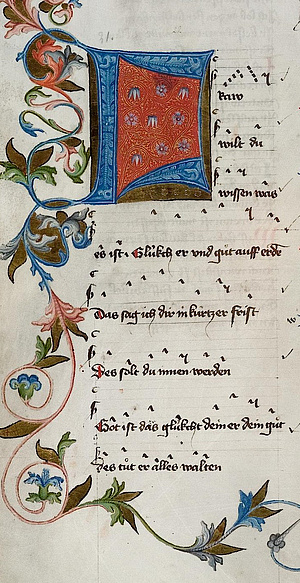Text and Song – the Medieval Song

Medieval lyric poetry has from the very outset been sung. The melodies reveal much about how the texts were understood and passed on – though in the early days of the German tradition of song the melodies were not written down. Presumably this was because many of them were familiar to people anyway and they could remember them. This makes it all the more interesting to learn that – and in what way – the notation of music in the late Middle Ages increased. Even where this was absent, one could nevertheless draw conclusions from the stanzas as to the musical structure of a piece of a lyric poem.
Exact knowledge of the different manuscripts, in which songs were passed down, is essential to an understanding of this genre. Medieval books were either highly representative in character or designed for private use. They could arrange the songs in cycles or combine them with other genres. All the different ways of how the songs were handed down tell us something about the understanding of the individual texts and of the entire genre, which prevailed at any particular time. This understanding is explored in depth in the project.
The project encompasses the following sections:
I. 1. The history and typology of the tradition of lyric poetry claiming to be of ‚literary‘ quality, which arose in the period up to circa 1350 (‘Minnesang’; ‘Sangspruchdichtung’ i.e. poems, mostly in strophes, intended to be sung; ‘Leichs’ i.e. songs with instrumental accompaniment; spiritual songs in the formal tradition of Minnesang).
I. 2. Descriptive register of the manuscripts from the 12th to the 16th century (circa 280 textual witnesses, predominantly codices: song manuscripts; songbooks and song booklets; collections or groups of songs in a context foreign to the genre in question, individual addendi and supplements, along with fragments; some scrolls; inscriptions, prints),
II. German art of the stanza in the use of Latin (examples of cases).
